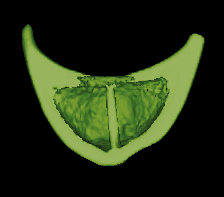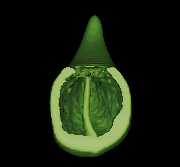
|
|
 |
| Home | Topics Research | Publications | Collaborations | Contact Us | People | Links |
|
|
High Energy Tomography |
A bronze Etruscan fibula (VIII-VII century B.C.) has been provided by Museo Archeologico of Bologna to be investigated. Fibulae were common objects of personal clothing and ornament with the shape and the function of a safety pin used to close and decorate clothes.
CT analysis has been carried out in order to obtain quantitative information about the material and to achieve a more accurate knowledge of manufacturing technique. It must be pointed out that museums all over the world hold a large number of similar samples; therefore, this technique could be applied as an ordinary tool of analysis on objects previously investigated (for data integration and comparison) or completely unexamined.
The fibula is about 10 cm large (edge-to-edge) and 5 cm high (edge-to-base)


The figure on the left shows the 3D reconstruction image of the sample; an axial selection of data-set has been made in order to allow the inner inspection of the object. The same choice has been made on the figure on the right but from a different viewpoint. These images clearly show the structure of the fibula. An accurate measure of bronze thickness can be performed on the whole volume of the sample recording important information about the manufacturing technique. Moreover 3d reconstruction allows to locate exactly the position of the internal rod and its characteristics (thickness, length and shape). In particular, from figure right, it is evident that the support rod is not straight (as expected) but crooked. This information was unknown and unpredictable before this analysis.
Webmaster: Rosa
Brancaccio